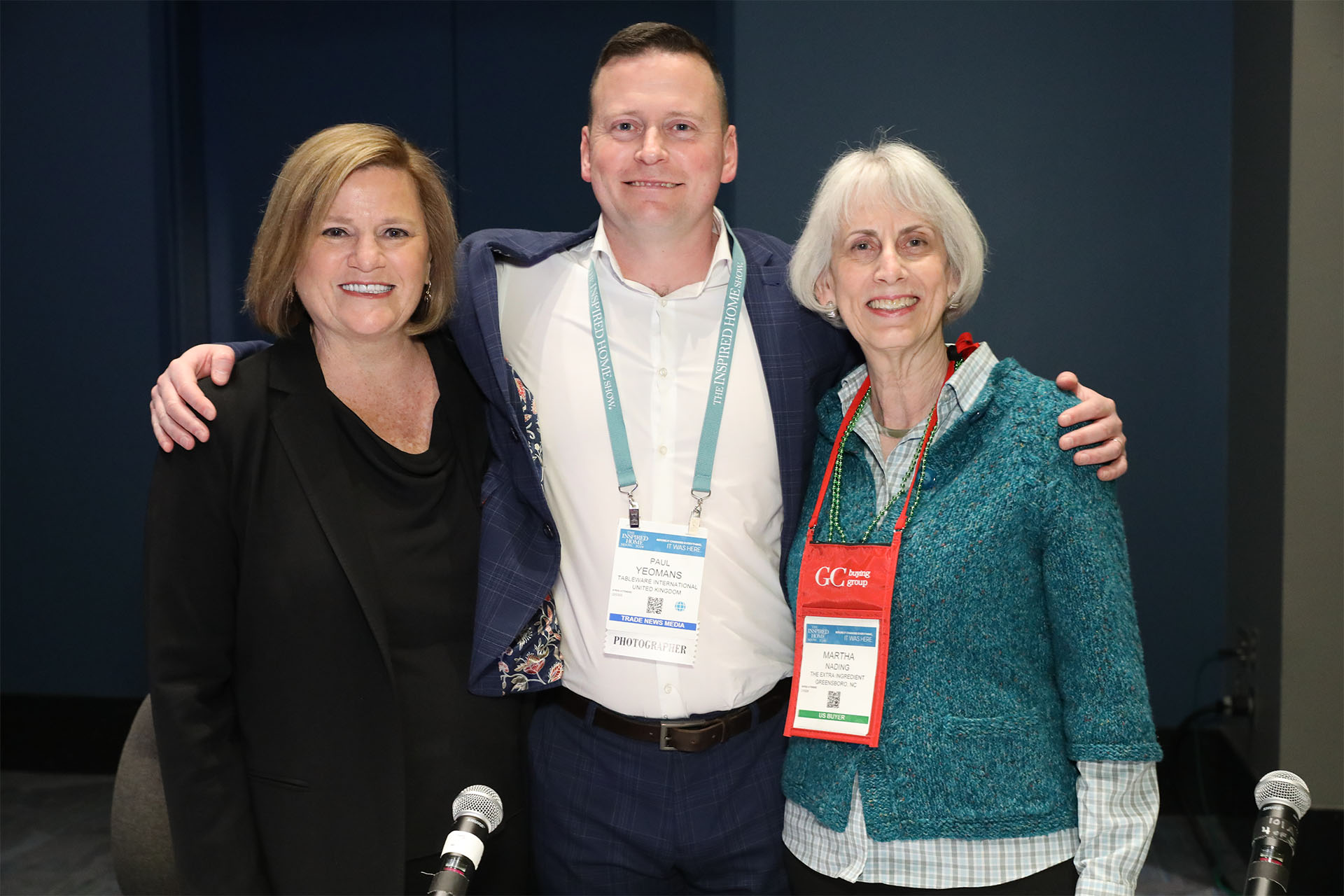The Inspiration Theater at The Inspired Home Show offered insight from experts into the evolution of the housewares marketplace and a vision of where it could go from a variety of perspectives, including product, retail, analysis and branding.
Refurbished Housewares Products: Unlocking New Markets, Not Cannibalizing Sales
Chris Lubick, Verdi Commerce
In the seminar Refurbished Housewares Products: Unlocking New Markets, Not Cannibalizing Sales, Chris Lubick, vp of business development and social impact at Verdi Commerce, pointed out that, with effective marketing, refurbished products can help brands reach new market segments and create additional value.
Lubick said the generational shift in commerce is changing how consumers shop, with more focus on e-commerce and social considerations among younger consumers. He said five megatrends favor the growth of refurbished products as consumers deal with changing circumstances: rapid urbanization, demographic shift, climate change and resource scarcity, the ongoing digital transformation of business and society at large, and emerging global wealth. Refurbished goods provide access to sought-after and even aspirational goods for consumers who may have more money but not enough to reasonably purchase some brands new. At the same time as they deal with cost, many consumers are looking for ways to shop sustainably. As such, refurbished goods give consumers a chance to purchase desired goods while doing something for sustainability and the building of a more circular economy.
Of the five megatrends, Lubick identified demographic shift, climate change and resource scarcity, and digital transformation as the most powerful in driving megatrends. Millennials surpassed baby boomers in population in 2019 and Gen Zers are likely to follow this year.
As they face a changing world and economy, 82% of consumers want to buy brands that align with their values, with Gen Zers and Millennials more prepared to pay for sustainable products. E-commerce gives consumers more access to refurbished goods, which grew by 7.6% in 2023.
From the brand perspective, refurbished goods can help with engaging incremental customer segments, especially price-sensitive, brand-aspirational and eco-conscious shoppers.
In looking at the segments, Lubick said price-sensitive shoppers have an explicit need to make a purchase. Their willingness to pay drives that purchase. Refurbished goods allow brands to effectively implement “non-disruptive price discrimination.” As such, they can reach price-sensitive consumers without discounting their mainline products.
The brand aspirational shopper is looking for a good buy but doesn’t necessarily have an explicit need, so actually winning conversion can be tough. Refurbished goods, by making a purchase more financially attractive, can win conversion for brands. Then, the eco-conscious shopper is purpose-driven. Refurbished products hold an attraction for them as an accessible and trustworthy step towards making a personal sustainable transaction.
How Influencers, AI and Amazon Are Shaping the Home + Housewares Category in 2024 and Beyond
John LeBaron, Pattern
In the seminar How Influencers, AI, and Amazon Are Shaping the Home & Housewares Category in 2024 and Beyond, John LeBaron, chief revenue officer at Pattern, a top e-commerce accelerator and Amazon’s largest marketplace seller, said that the proportion of sales online continues to grow in the United States even as e-commerce evolves. Worldwide e-commerce operators using marketplace formats now generate more e-commerce sales, as do grocery and social media. Of course, Amazon sales in the United States are shifting toward marketplace, even as Walmart, Macy’s and other major retailers are promoting their own version of the third-party e-commerce model.
Still, Amazon continues to be the driver of online sales in the U.S. and the place to begin shopping visits for two thirds of consumers.
“They don’t even go to Google anymore,” LeBaron said. “One of the biggest competitors to Google is actually Amazon, if not the biggest, because they are their own search engine.”
So, consumers now search for Amazon, including the sellers on its marketplace, which helps continue driving the company’s business. Yet, e-commerce and marketplace are only part of the story. Today, Amazon is a huge advertising seller, with those working with it spending more than $40 billion on ads, LeBaron indicated, a number that’s rapidly rising toward $50 billion.
“The way that Amazon got to $40-plus billion of ad revenue is they absolutely reengineered their whole website to be a sponsored-advertising generating machine,” LeBaron said. “If you have been in advertising for some time, you will recognize this evolution and you will recognize the impact on your wallet because you are spending more money than you ever have on advertising today.”
Pattern works with its clients to use factors such as keywords to help them build more organic or non-paid listings in top positions in search listings. However, LeBaron said doing so requires building expertise on Amazon operations and diligence to maximize the impact of strategies to improve organic search and land listings on the critical first Amazon search page when consumers are looking for goods.
Artificial intelligence will make Amazon’s ability to reach consumers even more sophisticated. Today, a simple product review can provide probabilities about a consumer’s identity and preferences that far exceed what might be supposed, right down to gender and ethnicity, despite neither being part of the review. In that case, Amazon will continue to develop more sophisticated data to make itself a continually more effective seller of merchandise, growing by effectively selling the fruits of that data to vendors and marketplace sellers.
As for influencers, today, Amazon listings will actually include the endorsement as seen on TikTok. With the approach it has taken to other elements of its business, Amazon will be working to use its ability to parse and identify which influencers under what circumstances will be most relevant and persuasive to specific consumers. Given the many thousands available to work with, Amazon is bound to apply its expertise to use influencers as a selling tool, particularly with younger consumers.

From L-R: Laurie Burns, Paul Yeomans, Martha Nading
Tableware 2024: Where is the Business Going?
Laurie Burns, Burns Consulting
Paul Yeomans, Tableware International
Martha Nading, The Extra Ingredient
The tableware business may not be changing as rapidly as Amazon, but emerging trends suggest that change is ongoing in that sector of the housewares business. Understanding how that’s occurring is key to getting ahead of the change and maximizing opportunity. In the session, Tableware 2024: Where is the Business Going? Laurie Burns of Burns Consulting, Paul Yeomans, publisher of Tableware International, and Martha Nading, owner of retailer The Extra Ingredient, discussed trends down the length of the sector.
On the manufacturing end, Yeomans said that more tabletop vendors are going to a China Plus One strategy where they identify manufacturers in other Southeast Asia countries due to cost increases, tensions with the U.S., and quality variations that have occurred in China. Circumstances suggest that simply relying on China as a source may no longer be a reasonable approach to manufacturing.
In terms of world styles, Yeomans said that after visiting trade shows such as those in Frankfurt and Paris over the past couple of months, “colored glassware definitely is a trend. I think in the U.S., too.”
In addition, he said, fluted glassware, mixed materials in barware and textured dinnerware, as well as blue and white, and black designs made gains. In tableware, metallic with gold rims, Asian-inspired bamboo flatware, as well as examples with colored handles using mixed materials, had an impact on the shows.
Burns stated that after the COVID-19 pandemic and ensuing turmoil in the economy, color has become more prominent in the market as an antidote to darker events, with yellows and blues strong. Burns said that color is gaining in importance and that’s showing up all over, as with The Pioneer Woman’s contribution at Walmart.
“It’s so colorful. If you haven’t been to Walmart lately, she’s got 50% of the tableware area right now,” Burns said.
A consideration in the tableware market is where Americans eat, which includes the dining room, kitchen, outdoors and on the go; it has changed how they look at the items they use for meals. Formal and casual dinnerware have melded. These days, melamine and acrylic are accepted by consumers as having thoroughgoing sophistication and are not just considered materials that belong on the patio. The reality is manufacturers are looking beyond melamine to the use of more natural materials to produce quality products with similar properties.
In a generational angle on developments, Nading said that her kids don’t do formal table settings at meals in their homes, “but they expect it at my house.”
Something to watch for in the future, Nading said, is how younger consumers evolve as they establish their own homes. As they have families, will they keep a casual attitude toward dining or become more formal? The question suggests a consideration that may be a good idea to monitor.
Learning to Listen: Satisfying the Insatiable Consumer
Tom Mirabile, Springboard Futures
In a broad evaluation of the marketplace conducted as part of the seminar Learning to Listen: Satisfying the Insatiable Consumer, Tom Mirabile (pictured top), Principal and Founder of Springboard Futures, conducted a review of the 2024 Value Equation Index, a tool developed to provide a view on the demands, desires and expectations of today’s consumers. In essence, the index identifies and provides key insights about the consumer value equation to create a comprehensive and actionable understanding of evolving consumer concerns and their effect on consumption and what’s driving consumer actions.
Rather than something like demographic-based analysis, the index looks at values as expressed in consumer demand. Among the values explored, trust is defined, in this case, as when a retailer or brand is credible, reliable, authentic and committed to delivering for its customers. The index looks specifically at home and housewares products, and when asked about the importance of trust, 36% of consumers said it is extremely important, 39% very important, 24% somewhat important, and only 1% unimportant. As for brand, in another example, 22% of consumers said it was extremely important, 28% said very important, 43% said somewhat important and 7% said not important.
The values can be broken down further. Take the value of quality, for instance. Quality is defined as built of reliability, safety, durability, desirable materials and aesthetics.
“When we look at this, durability and reliability are way at the top,” Mirabile said. “As the economy starts to get more difficult, we want things to hold their value more.”
Indeed, when asked which aspects of quality are most likely to influence their purchasing decisions, 57% said durability, followed by reliable performance at 46%, safety at 25%, ease of use at 23%, minimal care/maintenance at 18%, material composition at 16% and design/aesthetics at 15%.
Then, when it comes to the value of price, the index looks at it severally, with dollars and cents part of it but within the context of overall value as consumers evaluate it and what they are willing to pay. The index looks at the value both in terms of price and promotion. So, when it comes to purchasing decisions, 40% of consumers will wait for a promotion, while 37% are attuned to free shipping/returns. After that, 34% are motivated by rebates/coupons, 34% by a fair price and 33% by loyalty rewards, while 22% want updates via social media about price and promotion, which suggests they are motivated by receiving information that allows them to make determinations about the right value for them.
Across the analysis, some changes in consumer demand become evident. For example, Mirabile said that factors that have been considered determinants of demand have shifted. The old include demographics, caring about oneself and one’s family; delivering product; the life the consumer lives; retailers and big brands; brand size; and industrial-era consumption and all that entails. The new include psychographics, caring about the self, the family and society; delivering sharable experiences, the person the consumer wants to be; shopping wherever and whenever; and the digital era of consumption, with the ramifications of universal and continual access.

Adrienne Weiss
Branding Is Storytelling
Adrienne Weiss, Adrienne Weiss Corp.
As noted in the Value Equation Index, brand remains an important factor in the marketplace. In the session, Branding Is Storytelling, Adrienne Weiss, CEO of the Adrienne Weiss Corp., said, “If you’re trying to sell something to someone, you have a brand.”
Brand is a story. “It sounds like a throwaway line, but it’s not,” she said. “It’s literally at the heart of your business. There should be words and pictures like a storybook that tells the story of what you are doing.”
At the same time, a brand is a club that people want to join and enjoy. “If you think about this idea of clubness, that would make one person talk about your business to another and that to a third,” Weiss said.
In another perspective, “the brand is like a country that has its own rituals and customs and visuals,” she says.
It all adds up to a brand identity on which a business can build.
“There’s an emotional and intellectual idea at the heart of every brand,” she said. “That means there’s a feeling piece and a thinking piece. There is literally what the products are made of and what the customer may respond to. When you are working, think about what that emotional piece is and what that intellectual piece is. If you keep mirroring them up and make sure you’re not too heavy in one direction, you will be coming up with the right equation.”
Given that exercise, a company develops a filter through which it can evaluate ideas. Through that, a business can align everything from its name to the signage, the public relations campaign, the kid’s program, the customer service, the uniforms and the packaging.
Weiss said that, in using that approach, businesses can ensure customers understand and even get excited about what they are offering. She noted that, in working with Five Below, branding took a low-price, convenience store for tweens and teens and created a concept that used store layout (divided into departments meant to focus on products the target customers cared about, such as electronics and bright colors) to generate excitement to wheelbarrow and oil drum merchandisers suggesting value, and gave it relevance. Five Below became a store that offered desirable but affordable merchandise but also a stimulating shopping experience, which gave it cachet with young people and helped it grow into a chain with some 1,600 stores.





